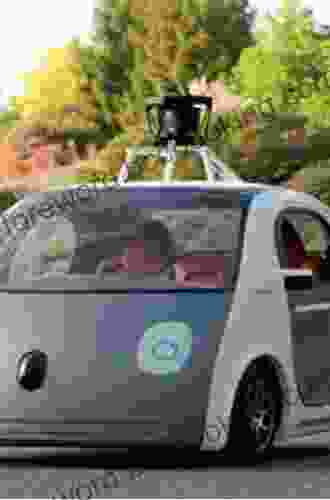Driverless Intelligent Cars: The Road Ahead

The advent of driverless cars is one of the most anticipated technological developments of our time. These vehicles have the potential to revolutionize transportation, making it safer, more efficient, and more accessible. However, there are also a number of challenges that need to be overcome before driverless cars can become a reality.
4.5 out of 5
| Language | : | English |
| File size | : | 4522 KB |
| Text-to-Speech | : | Enabled |
| Screen Reader | : | Supported |
| Enhanced typesetting | : | Enabled |
| Word Wise | : | Enabled |
| Print length | : | 314 pages |
In this article, we will explore the technology behind driverless cars, discuss the challenges that need to be overcome, and examine the potential benefits of these vehicles. We will also provide a glimpse into the future of driverless cars and discuss the impact they are likely to have on our lives.
The Technology Behind Driverless Cars
Driverless cars use a variety of sensors, cameras, and radar systems to perceive their surroundings. These sensors collect data about the car's position, speed, and direction, as well as the location of other objects in the environment. This data is then processed by a computer, which uses machine learning algorithms to make decisions about how to control the car.
The most important sensors used in driverless cars are lidar (light detection and ranging) sensors. Lidar sensors emit laser pulses and measure the time it takes for the pulses to bounce back. This information can be used to create a detailed three-dimensional map of the car's surroundings. Radar sensors are also used to detect the presence of other objects in the environment. Radar sensors emit radio waves and measure the time it takes for the waves to bounce back. This information can be used to determine the speed and direction of other objects.
In addition to sensors, driverless cars also use cameras to collect data about their surroundings. Cameras can be used to identify traffic signs, pedestrians, and other objects. Cameras can also be used to track the movement of other vehicles.
The data collected by the sensors, cameras, and radar systems is processed by a computer, which uses machine learning algorithms to make decisions about how to control the car. Machine learning algorithms are computer programs that can learn from data. These algorithms can be trained to recognize patterns in data and to make predictions. In the case of driverless cars, machine learning algorithms are trained to recognize traffic signs, pedestrians, and other objects. These algorithms can also be trained to make decisions about how to control the car, such as when to accelerate, brake, and turn.
The Challenges of Developing Driverless Cars
The development of driverless cars is a complex and challenging task. There are a number of technical challenges that need to be overcome before driverless cars can become a reality. These challenges include:
* Perception: Driverless cars need to be able to perceive their surroundings accurately and reliably. This is a difficult task, as the environment is constantly changing. Driverless cars need to be able to handle a variety of conditions, such as rain, snow, and fog. * Decision-making: Driverless cars need to be able to make decisions about how to control the car safely and efficiently. This is a complex task, as driverless cars need to take into account a variety of factors, such as the speed and direction of other vehicles, the presence of pedestrians, and the condition of the road. * Control: Driverless cars need to be able to control the car precisely and reliably. This is a difficult task, as driverless cars need to be able to handle a variety of conditions, such as slippery roads and strong winds.
In addition to these technical challenges, there are also a number of regulatory and social challenges that need to be addressed before driverless cars can become a reality. These challenges include:
* Liability: Who is liable in the event of an accident involving a driverless car? The car manufacturer, the software developer, or the owner of the car? * Privacy: Driverless cars collect a lot of data about their surroundings. This data could be used to track people's movements and to violate their privacy. * Safety: Are driverless cars safe? This is a question that needs to be answered before driverless cars can be allowed on public roads.
The Potential Benefits of Driverless Cars
Driverless cars have the potential to revolutionize transportation. These vehicles could make transportation safer, more efficient, and more accessible. The potential benefits of driverless cars include:
* Safety: Driverless cars have the potential to make transportation much safer. These vehicles could eliminate human error, which is the leading cause of traffic accidents. Driverless cars could also reduce the number of traffic jams, which could lead to fewer accidents. * Efficiency: Driverless cars could make transportation more efficient. These vehicles could travel more smoothly and efficiently than human drivers. Driverless cars could also reduce the amount of time that people spend driving, which could free up time for other activities. * Accessibility: Driverless cars could make transportation more accessible for people who are unable to drive. These vehicles could provide transportation for people who are blind, deaf, or elderly. Driverless cars could also provide transportation for people who live in rural areas or who have difficulty getting around.
The Future of Driverless Cars
The future of driverless cars is bright. These vehicles have the potential to revolutionize transportation and to make our lives safer, more efficient, and more accessible. However, there are still a number of challenges that need to be overcome before driverless cars can become a reality. These challenges include technical challenges, regulatory challenges, and social challenges.
Once these challenges have been overcome, driverless cars are likely to become a common sight on our roads. These vehicles have the potential to change the way we live and work. Driverless cars could free up our time, make our roads safer, and make transportation more accessible for everyone.
Driverless cars are a promising new technology with the potential to revolutionize transportation. These vehicles have the potential to make transportation safer, more efficient, and more accessible. However, there are still a number of challenges that need to be overcome before driverless cars can become a reality. These challenges include technical challenges, regulatory challenges, and social challenges.
Once these challenges have been overcome, driverless cars are likely to become a common sight on our roads. These vehicles have the potential to change the way we live and work. Driverless cars could free up our time, make our roads safer, and make transportation more accessible for everyone.
4.5 out of 5
| Language | : | English |
| File size | : | 4522 KB |
| Text-to-Speech | : | Enabled |
| Screen Reader | : | Supported |
| Enhanced typesetting | : | Enabled |
| Word Wise | : | Enabled |
| Print length | : | 314 pages |
Do you want to contribute by writing guest posts on this blog?
Please contact us and send us a resume of previous articles that you have written.
 Book
Book Novel
Novel Page
Page Chapter
Chapter Text
Text Story
Story Genre
Genre Reader
Reader Library
Library Paperback
Paperback E-book
E-book Magazine
Magazine Newspaper
Newspaper Paragraph
Paragraph Sentence
Sentence Bookmark
Bookmark Shelf
Shelf Glossary
Glossary Bibliography
Bibliography Foreword
Foreword Preface
Preface Synopsis
Synopsis Annotation
Annotation Footnote
Footnote Manuscript
Manuscript Scroll
Scroll Codex
Codex Tome
Tome Bestseller
Bestseller Classics
Classics Library card
Library card Narrative
Narrative Biography
Biography Autobiography
Autobiography Memoir
Memoir Reference
Reference Encyclopedia
Encyclopedia Nathan D Lang Raad
Nathan D Lang Raad Kathryn Holmes
Kathryn Holmes Honey Phillips
Honey Phillips Luis Preto
Luis Preto Ho Fung Hung
Ho Fung Hung Herschel Knapp
Herschel Knapp Henry Worsley
Henry Worsley Nigel Hollis
Nigel Hollis Michael Schiavone
Michael Schiavone Micheal J Murphy
Micheal J Murphy Steve Doocy
Steve Doocy Heidi Dais
Heidi Dais Hawa Hassan
Hawa Hassan Holly Ice
Holly Ice Hemang Doshi
Hemang Doshi Hayley Mills
Hayley Mills Henry James
Henry James Harriott Pinckney Horry
Harriott Pinckney Horry Pamela Craft
Pamela Craft Henry M Holden
Henry M Holden
Light bulbAdvertise smarter! Our strategic ad space ensures maximum exposure. Reserve your spot today!

 Darius CoxBlade of the Immortal Volume 19: Badger Hole - A Masterpiece of Swordplay and...
Darius CoxBlade of the Immortal Volume 19: Badger Hole - A Masterpiece of Swordplay and... Dillon HayesFollow ·14.6k
Dillon HayesFollow ·14.6k Nathaniel HawthorneFollow ·2.7k
Nathaniel HawthorneFollow ·2.7k Tennessee WilliamsFollow ·8.4k
Tennessee WilliamsFollow ·8.4k Jason HayesFollow ·17.3k
Jason HayesFollow ·17.3k Ralph EllisonFollow ·15.3k
Ralph EllisonFollow ·15.3k Chuck MitchellFollow ·16.9k
Chuck MitchellFollow ·16.9k Jules VerneFollow ·8.5k
Jules VerneFollow ·8.5k Ryan FosterFollow ·3.4k
Ryan FosterFollow ·3.4k

 Fabian Mitchell
Fabian MitchellUnleash the Adventure: Family Fun in the Black Hills
Nestled amidst the rolling hills...

 Alfred Ross
Alfred RossUnleashing Peak Business Performance: A Journey of...
In today's rapidly evolving business...

 Fernando Bell
Fernando BellEmbrace the Prophetic Voice of Howard Zinn: A Journey...
As we navigate the complexities of our...

 Jonathan Franzen
Jonathan FranzenChildren of the Arctic: A Literary Expedition to the...
In the annals of...

 Branson Carter
Branson CarterYou Can Be Neutral on a Moving Train: A Transformative...
Welcome, dear reader,...
4.5 out of 5
| Language | : | English |
| File size | : | 4522 KB |
| Text-to-Speech | : | Enabled |
| Screen Reader | : | Supported |
| Enhanced typesetting | : | Enabled |
| Word Wise | : | Enabled |
| Print length | : | 314 pages |












